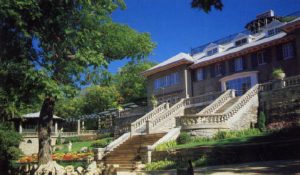The Mayowood Mansion Oak: A Case Study in Saving an Old Tree
The article below was written by Jay Maier, owner of Maier Forest and Tree, an RNeighborWoods Partner.
Sometimes trees just make the place. Charlie Mayo knew this when he built his home (the current Mayowood Mansion). He selected a site based on one particular tree. This white oak, now located in the mansion’s back courtyard, is struggling to survive because the root zone is not getting the nutrients, oxygen or water it needs. This tree has been Adopted by Maier Forest and Tree and we will now use it as a case study of the kinds of things we can do to keep important trees around.
Step one in saving an old tree is a quality assessment. The first inspection on the Mayowood Mansion oak occurred in August, 2007. Overall the tree was in decent health, especially considering the age and location. However, the leaves are yellowing and the crown has some major dead limbs. There is no significant decay in the trunk or branches nor is there obvious root loss.
Step two in saving an old tree is to make it safe. The courtyard is heavily used and because of this we need to remove the dead limbs. This somewhat obvious recommendation has a not-so-obvious caveat. Old trees do not heal wounds very well. It is critical that the pruning cuts be made outside the branch collar to prevent further decay. It is also critical to limit pruning to dead limbs only, as the live limbs are critical to the trees survival. We will properly prune the oak to remove major deadwood.
Step three in saving an old tree is to stabilize its health through good nutrition and growth regulation. Even though the yellow leaves are a symptom of poor nutrition, the fact they are yellow causes a real problem. Yellow leaves lack chlorophyll, the food factories of the tree. The lack of food production over years decreases the tree’s ability maintain its health and vigor. Yellowing is typically a symptom of an iron deficiency. We will inject a form of iron called chelated iron directly into the tree to correct this problem.
Cambistat growth regulator will also be applied to the soil at the base of the tree. The growth regulator works to redistribute the trees energy from canopy growth into root growth and defense chemicals. This provides several benefits to the oak. First, the branches will grow slower which results in less future pruning. Second, more energy goes into fibrous root growth. Fibrous roots are the hair-like roots that absorb water and nutrients. The root area on this tree has little unpaved area to receive air and water (Fortunately the drive and patio are brick which allows water and air seeps into the soil through the cracks). Third, the growth regulator causes an increased production of defense chemicals, meaning the oak can better fight off decay, disease and insects.
In the hands of good Arborists, this tree should be around for the next 100 years.
